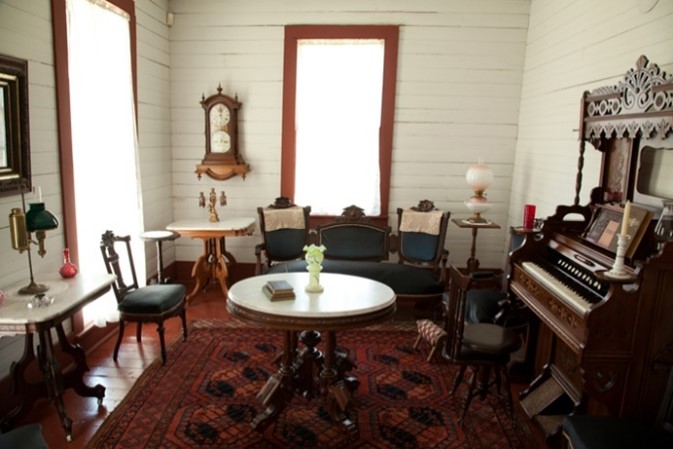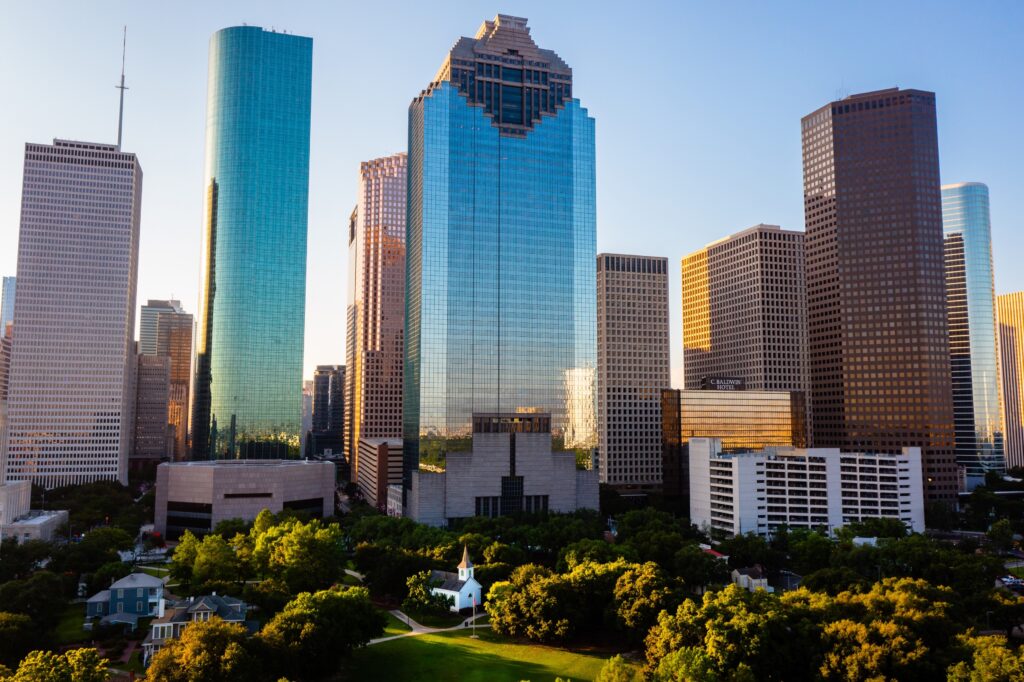By Katherine R. Galland
Tucked between the high-rises that make up Houston’s iconic skyline sits Sam Houston Park. The city’s first municipal park, which was known as City Park until 1902, Sam Houston Park has long been a place where Houstonians go to escape the hustle and bustle of downtown, but it is more than that. With several of Houston’s oldest homes located on site, the park itself is a valuable piece of Houston history where the story of Houston and past Houstonians live on within its gates, imparting their stories to visitors. Accessible thanks to The Heritage Society, these homes serve as an important reminder of where Houston has come from and where it could be going.
The City of Houston under Mayor Samuel Brashear purchased the initial tract of land for the park in 1899. In the early 1900s, the park featured a popular wading pool to beat the Texas heat and served as Houston’s first zoo. A jaguar, lynx, doe, civet cat, sparrow hawk, and more all called this quiet part of downtown their home until 1905 when the zoo was shut down and the animals were moved to Little Rock. This left the city without a zoo until 1922, when the Houston Zoo in Hermann Park opened.
As for Sam Houston Park, it served as a quiet refuge until 1954 when it had a different “animal” to protect through conservation – not an exotic species this time, but a Houston home, now known as Kellum-Noble House. The city’s oldest standing residence, it is located within the park and had been used as headquarters for the Park Department since the park’s founding. The home, built in 1847 by Nathaniel Kellum using enslaved laborers, remarkably rests on its original foundation and retains original bricks crafted in Kellum’s brickyard on Buffalo Bayou. Over the years, the house had fallen into disrepair, and a fire had damaged an addition that was not part of the original structure. The city announced plans to demolish Kellum-Noble in 1954, and the Harris County Heritage and Conservation Society (now The Heritage Society) formed to preserve the home.

Founding of The Heritage Society and Restoration of Kellum-Noble
According to founding member and Houston architect Harvin Moore, the Society was born when “a group of ladies invited [a] committee to assist in the organization of the Heritage Society [to] raise funds primarily to restore the Kellum-Noble house in Sam Houston Park.” This group of women, and the men they invited, consisted of key players in Houston society: Birdsall Briscoe, Charles and Faith Bybee, C. C. “Pat” Fleming, Kenneth Franzheim, Maria T. Gregory, Mary Van Den Berge Hill, Ima Hogg, Harvin C. Moore, Sr., Marie Lee Phelps, Alvin S. Romansky, Mary Ellen Shipnes Martin, and Ellen Hamilton Wilkerson. Their decision to band together to save Kellum-Noble eventually resulted in a much larger project.
The founding members of The Heritage Society showed commitment to conservation inside and out of the group’s walls throughout their lives. An architect for many homes in Houston’s historic River Oaks neighborhood, Birdsall Briscoe served as lead architect for multiple houses on the National Register for Historic Places. An associate architect to John F. Staub in developing the Bayou Bend mansion in River Oaks, Briscoe consulted with another founding member of The Heritage Society, Ima Hogg, who lived in the mansion until 1965.
Ima Hogg was one of the most prominent of the founding members, dubbed “The First Lady of Texas.” The Hogg family’s fortune came from oil found on the Varner Plantation, but the family did not believe the money was theirs because it came from the earth, so they used it for the good of Texas. Ima Hogg herself was an art collector, who donated hundreds of pieces to the Museum of Fine Arts, Houston. She served on a committee to locate historic furniture for the White House and received the Louise E. du Pont Crowninshield Award from the National Trust for Historic Preservation. In 1943, she ran for Houston School Board where she worked to remove gender and race as criteria for determining pay.

Several others brought notable experiences to the organization. Founding member Marie Lee Phelps McAshen, who published On the Corner of Main and Texas, a Houston Legacy, helped establish the Houston Zoo. Mary Van Den Berge Hill served as president of the Garden Club of Houston. Pat Fleming, a National Park Service landscape architect, oversaw the landscape development of the San Jacinto Monument and created many residential and other garden landscapes in his career. Charles and Faith Bybee dedicated their lives to preserving historic homes and were involved with the Houston Symphony Society.
The group worked to save Kellum-Noble, which still stands in the park today. The founding members influenced not only the creation of The Heritage Society but also the development of Houston as a whole, and their legacies lives on through the work being done by today’s members and donors to The Heritage Society.
To read the full article, click on Buy Magazines above to subscribe or order a print copy.
Visit The Heritage Society to lean more.




 Follow
Follow